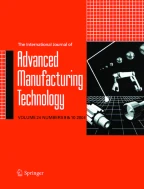Abstract
The Failure Mode, Effects and Criticality Analysis (FMECA) has been widely applied in the reliability research of machining centers in recent years. However, conventional FMECA does not take opinions of different team members or the relationship between the modes and causes of failure into account when considering the assignment of criticality. Thus, an improved FMECA (IFMECA) is proposed to overcome the disadvantages. The IFMECA method applied group decision-making theory to effectively combine every team member’s evaluation. Subsequently, weights of the factors were determined based on the combination of entropy and expert evaluation. Failures were then prioritized by decision-making trial and evaluation laboratory (DEMATEL) method. In this paper, improved criticalities (ICR) were calculated and failures of feed systems were prioritized by IFMECA based on the failure data of the feed system. According to the rank of failure modes obtained through IFMECA, it is observed that vibration or oscillation, motion parts output failure, and inaccurate re-home have more negative impacts on the feed system. Furthermore, this paper asserts that IFMECA method could also be applied to analyze other complex mechanical systems.
Similar content being viewed by others
References
Ben-Daya M, Raouf A (1996) A revised failure mode and effects analysis model. Int J Qual Reliab Manag 13(1):43–47
Gilchrist W (1993) Modelling failure modes and effect analysis. Int J Qual Reliab Manag 10(5):16–23
US Department of Defence (1984) Procedures for performing a failure mode effects and criticality analysis. Department of Defence (USA) MIL-STD-1629
Ford Motor Company (1988) Potential failure mode and effects analysis in design (Design FMEA) and for manufacturing and assembly processes (Process FMEA) instruction manual. Ford Motor Company, Dearborn
European Cooperation for Space Standardization (2001) Failure modes, effects and criticality analysis. European Cooperation for Space Standardization ECSS-Q-30-02A
Wang J, Ruxton T, Labrie CR (1995) Design for safety of engineering systems with multiple failure state variables. Reliab Eng Syst Saf 50:271–284
Sankar NR, Prabhu BS (2001) Modified approach for prioritization of failures in a system failure mode and effects analysis. Int J Qual Reliab Manag 18(3):324–335
Bowles JB, Peláez CE (1995) Fuzzy logic prioritization of failures in a system failure mode, effects and criticality analysis. Reliab Eng Syst Saf 50:203–213
Anand P, Jin W (2003) Modified failure mode and effects analysis using approximate reasoning. Reliab Eng Syst Saf 79(1):69–85
Zeshan K, Tim PK (2007) Using fuzzy self-organising maps for safety critical systems. Reliab Eng Syst Saf 92:1563–1583
Seyed-Hosseini SM, Safaei N (2006) Reprioritization of failures in a system failure mode and effects analysis by decision making trial and evaluation laboratory technique. Reliab Eng Syst Saf 91:872–881
Haibo Z, Yazhou J (2004) Failure Mode, Effects and Criticality Analysis (FMECA) of CNC system. China Mech Eng 15:491–493
Wang YQ, Jia YZ, Jiang WW (2001) Early failure analysis of machining centers: a case study. Reliab Eng Syst Saf 72:91–97
Chryssolouris G (1987) MADEMA: an approach to intelligent manufacturing systems. CIM Rev 3(3):11–17
Braglia M, Frosolini M, Montanari R (2003) Fuzzy TOPSIS approach for failure mode, effects and criticality analysis. Qual Reliab Eng Int 19:425–443
Borda JC (1781) Mémoire sur les Élections au Scrutin. Histoire de l’Académie Royale de Science Paris
Condorcet M (1785) Essai sur l’application de l’analyse à la probabilité des décisions rendues à la pluralité des voies. Imprimante Royale Paris
Arrow KJ (1951) Social choice and individual values. Wiley, New York
Khaled J (2007) An ordinal sorting method for group decision-making. Eur J Oper Res 180:1272–1289
Tsiporkova E, Boeva V (2006) Multi-step ranking of alternatives in a multi-criteria and multi-expert decision making environment. Inf Sci 176(18):2673–2697
Bryan LB, Michael RB, Reeshad SD (2002) The effects of member expertise on group decision-making and performance. Organ Behav Hum Decis Process 88:719–736
Chin KS, Wang YM, Poon GKK, Yang JB (2009) Failure mode and effects analysis using a group-based evidential reasoning approach. Comput Oper Res 36:1768–1779
Claude ES (1948) A mathematical theory of communication. Bell Syst Tech J 27:379–423
Zhu AM, Yu LJ (2000) Application of entropy- fuzzy evaluation method to selection of talent. J Shenyang Univ Technol 22:69–70
Fontela E, Gabus A (1976) The DEMATEL observer, DEMATEL 1976 report. Battelle Geneva Research Center, Geneva
Jia YZ, Cheng XM, Jia ZX (1997) Failure mode analysis of machining centers. Proceedings of the Third ISSAT International Conference Reliability and quality in design, California, USA 74–76
Dhouib K, Gharbi A, Landolsi N (2010) Availability modelling and analysis of multi-product flexible transfer lines subject to random failures. Int J Adv Manuf Technol 78:139–152
Moradi E, Zandieh M (2010) Minimizing the makespan and the system unavailability in parallel machine scheduling problem: a similarity-based genetic algorithm. Int J Adv Manuf Technol 51:829–840
Author information
Authors and Affiliations
Corresponding author
Rights and permissions
About this article
Cite this article
Wang, X., Zhang, Y. & Shen, G. An improved FMECA for feed system of CNC machining center based on ICR and DEMATEL method. Int J Adv Manuf Technol 83, 43–54 (2016). https://doi.org/10.1007/s00170-015-7551-y
Received:
Accepted:
Published:
Issue Date:
DOI: https://doi.org/10.1007/s00170-015-7551-y
